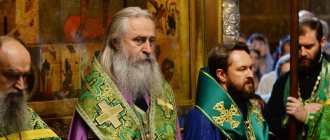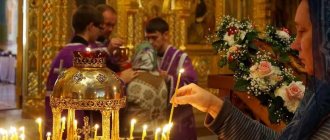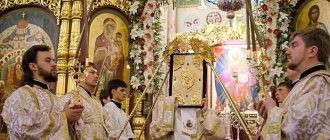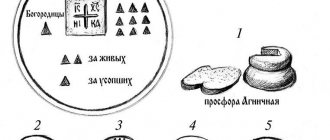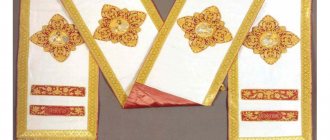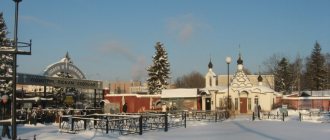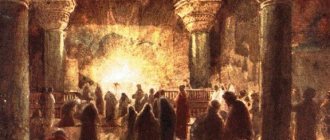Christian Foundations of the Eucharist
Two thousand years ago, Christ at the Last Supper left the commandment to take communion in memory of Him, eating bread and wine. Modern Christians partake of His Blood through this sacrament performed during the Divine Liturgy.
The Divine Liturgy is the most important service
In former times, the Great Service was called mass, Catholics celebrate the sacrament at mass.
The first Christians in Jewish society were perceived as a sect, and therefore were persecuted. Carrying the gospel of Christ into the world, talking about the meaning of the Eucharist, the disciples of Jesus were constantly under attack from society, so their services were often held under the veil of secrecy.
After ministering to the pagans, the Apostle Paul defended the proposal to allow newly converted pagans to receive communion without observing the law of Moses on circumcision. At the first services, psalms were read almost daily, sermons were spoken, prayers were sung, and all services ended with the remembrance of the Last Supper. At common prayers, Christians broke bread and took wine every day, remembering the earthly life of the Savior.
Read about the Orthodox Church:
- What types of Orthodox monasteries are there?
- Why and for what does the church collect money?
- Who is a vicar in the Orthodox Church
This action will later be called the Eucharist, which is the central part of the Divine ministry. Unlike Jews, Christians:
- refused blood sacrifices, accepting the one and final sacrifice, God's Lamb, Jesus Christ;
- can ordain any person on earth who has converted to Christianity, and not just the descendants of Aaron;
- the whole world is chosen as a place of service;
- prayer services can be held both during the day and at night;
- hours were introduced during the service.
Development of Christian worship
The tradition of worship dates back to Old Testament times. This is exactly how the first Christians perceived it, who were considered a Jewish sect in the eyes of society. This was understandable - the Holy Apostles came from Palestine, received a Jewish upbringing and followed the behests of their ancestors.
But it was then, in the years of the first sermons reflected in the Acts of the Apostles, that the history of modern service begins.
You may find information on how to organize a wake for 9 days useful.
Sermon and Eucharist
The followers of the teachings of Christ were far from enjoying a privileged position in the Roman Empire. They were persecuted, so their meetings were held secretly. Someone's house or even a cemetery was chosen for meetings; the latter gave temporary immunity to those present in it according to Roman laws.
At first, Christians living in Palestine freely visited the Jerusalem Temple. This practice was stopped after the Jewish War, when Jerusalem was destroyed by Roman troops and a final break occurred between Jews and Christians.
The apostles Paul and Barnabas concluded during their missions that converted Gentiles did not need to be persuaded to obey the Law of Moses. This applied to both everyday life and worship. The apostles believed that the new teaching was intended for all people, regardless of their origin. In principle, it could not fit into the framework of Judaism and the Temple, and it was not necessary. It was believed that one could serve the Lord all over the world.
The first services consisted of the reading of psalms, prayers, a sermon and the remembrance of the Last Supper. The last is most important - it was a memory of the events leading up to the execution of Christ. It was accompanied by the breaking of bread and drinking wine, which symbolized the body and blood of the Lord. This would later become a sacrament called the Eucharist.
And while they were eating, Jesus took bread, blessed it, broke it, gave it to them, and said, “Take, eat, this is My Body.” And he took the cup, gave thanks, and gave it to them: and they all drank from it. And he said to them, “This is My Blood of the New Testament, which is shed for many.”
The Gospel of Luke also mentions the continuation of his words - “do this in remembrance of Me.”
Since then, partaking of the body and blood of Christ has been an integral part of worship.
Development in the first centuries
Spreading throughout the Mediterranean, Christianity increasingly acquired the features of a worldwide teaching. This was facilitated by Greek philosophy, which organically entered the theological works of apologists.
The liturgical rite also acquires Hellenic features. For example, the choral singing that accompanies the service comes specifically from the Balkans. A group of Church ministers is gradually identified, and the continuity of ordination is observed. Despite the fact that the ritual in its key features followed the service in the Jerusalem Temple, a different meaning was invested in it. Important differences between Christian worship and Jewish worship are the following:
- rejection of blood sacrifice - although the altar is present;
- the availability of ordination for any Christian, and not for the descendants of Aaron;
- the place of service can be the whole world;
- The time frame for the service expanded - Christians also prayed at night.
This attitude towards service was not accidental. A Jew was considered righteous insofar as he kept the Law of Moses and was faithful to its letter. The Christian followed not the letter, but the spirit, and faith itself was more important to him.
After the legalization of the doctrine under Constantine the Great, Christians were given church buildings, and worship began to develop in a modern direction. An hourly service appears, a list of sacraments is approved, the requirements are systematized - Baptism, Wedding, Anointing, and an all-night vigil on the eve of Easter becomes a practice. But the central sacrament remains the Eucharist, which has become the basis of the Divine Liturgy.
Liturgical hours
Prayers, the reading time of which is determined by the time of day, are called hours. During these prayers, which last only a quarter of an hour, maximum concentration of attention is required from those present in order to escape from the bustle of the world and feel God's presence in its entirety.
Liturgical Hours are a special rite of prayer that is read in church at a certain time.
After the hours, which begin at six in the evening, the usual worship service takes place.
The Divine service begins with Vespers and Complines, which begin at 17.00 and 21.00, respectively.
The night service ends with Midnight, followed by Matins, which begins at 7 a.m. and includes the prayer of the First Hour. The third hour is read at 9 am, the Sixth is at 12.00, the day's prayers end with the Ninth hour at 3 pm. The Divine Liturgy is served from the Third to the Ninth Hours, although each church has its own schedule.
Fasting, holidays and special dates make adjustments to the schedule of prayer hours. For example, before Holy Resurrection, the night vigil combines such services as Vespers, Compline and Midnight Office.
Important! The Divine Liturgy and Eucharist are not celebrated on Good Friday.
Read about other days of Holy Week:
- Maundy Monday
- Great Wednesday
- Maundy Thursday
Church Time: Hours
After the All-Night Vigil, the first hour is read in churches. Before the Liturgy, the third and sixth, and sometimes the ninth. And then there is the “great or royal clock.” What kind of rites are these, and what relation do they have to real time? Watch
- This is a short service. There are first, third, sixth and ninth hours. They are based on psalms (three in each), as well as chants associated with the day of the week, with the memory of a particular saint or other holiday.
The name of the clock itself is associated with ancient time counting systems. In Antiquity and the Middle Ages, the day was divided into several parts among different peoples. The tradition of Orthodox worship reflects the so-called Roman account:
“The day was divided into hours of unequal length; it was a more or less Christianized old Roman clock. The hour was approximately equal to our three: Matins (about midnight), Praises (3 o'clock in the morning), the first hour (6 o'clock in the morning), the third hour (9 o'clock), the sixth hour (noon), the ninth hour (15 o'clock), Vespers ( 18 o’clock), for eternity (21 o’clock)” (Jacques Le Goff. The Civilization of the Medieval West).
Note that the order of services is related to the daily cycle, and the hours should ideally have been performed in the intervals between services. In practice, even in a monastery it is impossible to ensure that the monks are constantly in the church, and therefore the hours gradually began to be adjacent to the main services (All-Night Vigil and Liturgy).
But in the texts themselves there were still references to the time of day or to New Testament events.
First hour
dedicated to “the thoughts and feelings of believers when morning comes” (M. Skablanovich “Explanatory Typicon”). This rite appears in Palestinian monasteries no earlier than the 4th century. Like the rest of the hours, the first hour consists of psalms (5, 89, 100), several prayers and troparions.
Much earlier, Christians began to highlight the Third, Sixth and Ninth Hours, associated with the descent of the Holy Spirit on the Apostles, the crucifixion and death of the Savior. Already in the 2nd century, Christians read the “Our Father” prayer at this time, and a special order for each of the services gradually formed.
Texts of the third hour
(approximately 9 am) is closely connected with the memory of two events in New Testament history - Pilate’s trial of Christ and the descent of the Holy Spirit on the apostles: “The general theme of the 3rd hour is a natural prayer at the beginning of the day for the preservation of Righteousness.” But in accordance with the two memories associated with this hour for a Christian, this theme is doubled: according to the “Teaching News” of the Service Book, the 3rd hour recalls the trial of the Savior by Pilate with scourging and reproach, which took place precisely between 9 and 12 noon, and the descent of the Holy Spirit on the apostles, which followed exactly at this hour.” (M. Skablanovich “Explanatory Typicon”). The third hour also consists of three psalms (16, 24, 50), several troparions and prayers.
Sixth hour
(approximately 12 days) is dedicated to the memory of the crucifixion of Christ.
This connection to the suffering of the Savior is connected with the testimony of the Gospel of Matthew: “From the sixth hour there was darkness over all the earth until the ninth hour;
and about the ninth hour Jesus cried out with a loud voice: Either, Or! Lama Savakhthani? that is: My God, My God! Why have you forsaken me? Some of those standing there, hearing this, said, “He is calling Elijah.” (Matt. 27:45-47). All three psalms (53, 54 and 90) describe the feelings of the righteous when surrounded by enemies.
In modern parish practice of the Russian Orthodox Church, the Third and Sixth Hours are usually read before the liturgy (at this time the priest performs proskomedia in the altar).
Quite often they are accompanied by the Ninth Hour
(approximately 15 hours), which is dedicated to the memory of the Savior’s death on the cross.
And this connection is based on the testimony of the Evangelists, for example Matthew: “And immediately one of them ran, took a sponge, filled it with vinegar, and putting it on a reed, gave Him to drink;
and others said, “Wait, let’s see if Elijah will come to save Him.” Jesus cried out again with a loud voice and gave up the ghost. And behold, the curtain of the temple was torn in two, from top to bottom; and the earth shook; and the stones were dispersed” (Matthew 27:47-51). Three psalms (83, 84, 85) are devoted to the theme of separation of the soul from the body.
According to the charter of the Church, the Ninth Hour is celebrated before Vespers, but in many parish churches it is omitted, or read before the liturgy, when the priest does not have enough time to perform proskomedia.
These four hours (1,3,6, and 9) are read in the church all year round, but on special occasions the Church uses other services, which are also called hours.
During Lent, the texts of kathisma are added to the usual hours (the Psalter is divided into 20 approximately equal parts for ease of use during worship. One of these parts is called kathisma), the Lenten troparia, the prayer of St. Ephraim the Syrian “Lord and Master of my life” and the reading of the Old Testament ( proverbs from the book of the prophet Isaiah) at the sixth hour. These extended hours are called “Lenten” hours.
It remains for us to talk about the Great (Royal) Hours, which take place three times a year - on the eve of the Nativity of Christ and the Epiphany, as well as on Good Friday. They include all the regular hours in a row (from 1 to 9), to which are added readings from the Old Testament, the Gospel and the Apostle, as well as special troparia.
The name “royal” is common only in Russia. Our liturgical tradition was taken from the Byzantine Empire. The emperor himself was supposed to be present at these solemn hours. Byzantine rulers and Russian tsars abandoned all other matters and hurried to the temple. In memory of this and to emphasize the special solemnity of these services in Rus', and then in Russia, the name “royal hours” began to be used.
There is another type of this service - Easter hours
, which on Bright Week are not only sung in churches instead of the usual hours, but also replace the morning and evening rules for believers. They are very short. They consist of the Easter troparion, the hymn “Having seen the Resurrection of Christ,” the Easter kontakion and several more troparions and prayers. No psalms, almost no reading. Only joyful chants in honor of the Savior.
The announcement features a miniature from the medieval Book of Hours.
Andrey Zaitsev
Based on materials from the magazine “Foma” and the website www.foma.ru
Sequence of the Divine Liturgy
The sacrament of Communion in Orthodoxy is called the Eucharist; the service at which Communion is celebrated is the Liturgy. This word in Greek consists of two components, the first means public, derived from part of the word “litos”, the second - “ergos” translated means service.
The liturgy, as a rule, is celebrated before lunch and consists of three parts:
- Proskomedia;
- Liturgy of the Catechumens;
- Liturgy of the Faithful.
The origins of the great ministry began in early Christianity, changes occurred in the church itself, but both the basis and symbolism remained unchanged.
Items for the Liturgy
Divine services during which the Eucharist is celebrated take place almost every day, with the exception of some days during Lent, Nativity, on Wednesday and Friday of the week preceding Easter abstinence and several days, you can find out about them in the church schedule.
During the great service, the life of the Savior is remembered, from the Annunciation to His Resurrection.
Proskomedia
During the reading of the health and funeral prayer, the doors of the altar are closed, behind them the priest prepares bread and grape wine for the Eucharist.
When the Great Gifts are ready, the Third and Sixth Hours are read, remembering all the prophecies from the Old Testament about the birth of the Messiah and the Nativity of Jesus itself. During Proskomedia, the Saints, prophets and apostles who have gone to God are remembered.
Liturgy of the Catechumens
The unusual name of this service comes from the fact that not only people who accepted Orthodoxy through Baptism were allowed to attend it, but also those who were preparing to do so, the catechumens. This part of the Divine service is designed to prepare those present to receive the Holy Gifts.
Antiphonal singing begins the second part of the service with the singing of “The Only Begotten Son”, then the priests bring out the gospel, after which the singing continues, the prokeimenon and the sermon begins.
Liturgy of the Catechumens
The choir sings “Hallelujah” and verses from the Psalter, after which the sermon is read again, which ends with a litany - a prayer request. In this part, the service differs from the other two in that for each verse “Amen” or “Lord, have mercy” is heard, after which the believers make the sign of the cross.
On a note! Previously, the catechumens left the temple; currently they remain in place, but only as observers and not participants.
Liturgy of the Faithful
The Cherubic song sounds before the Great Procession, which opens the third part of the Divine Liturgy. Having opened the Royal Gates of the altar, the deacon, reading Psalm 50, makes a tour:
- throne;
- altar;
- iconostasis;
- priest;
- parishioners
The Holy Gifts are transferred to the throne, after which the Royal Doors are closed and the “Creed” is read.
The Anaphora, read below, is the main part of the Liturgy. This is a Eucharistic prayer in which the Last Supper is remembered, the Holy Spirit is invoked and an intercessory petition is heard for the living and those who have gone to Heaven. During the anaphora, the divine transformation of bread and wine into the Holy Gifts takes place - the Body of the Lord and His Blood.
Anaphora is a Eucharistic prayer read by a priest
Communion begins after reading the Lord's Prayer “Our Father.” Christians must fast for three days before receiving Communion. The Divine Liturgy is a symbol of the reproduction of the Savior’s life on earth; each action of the great service has its own meaning.
After the Eucharist, the deacon pronounces a short litany with thanksgiving to the Almighty for Communion, after which the parishioners are sent home in peace.
